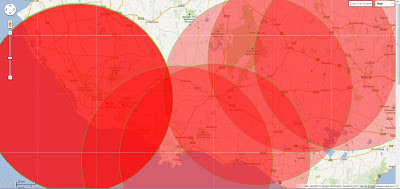Some may slowly shake their heads at the sheer tonnage of callous irony I pour into my rhetoric. Lay down your weaponry, my friends. I consider all things carefully, devoid of bias. I am a titan of objectivity.
Let us direct our gaze towards a wonderful article, published by George Papadopoulos, on 'Wind-Watch'. Wind-Watch claims to be 'presenting the facts about industrial wind power'. George writes the following facts, about industrial wind power:
"Where does the problem stop? This is a difficult question to answer. On two occasions when the ILFN [Infrasound-Low Frequency Noise] nuisance was at its worst, I traveled out west. On one occasion I discovered that it appeared to have dissipated at Wee Jasper, 70km away from the closest turbines.
On another occasion, and by far the worst of all days, the problem had dissipated when arriving at Young about 100km from the closest turbines."
To avoid the effects of infrasound and low-frequency noise emitted by wind turbines, you must travel 100 kilometres away from the wind turbines. If you were to travel 100 kilometres upwards instead of sideways, that officially puts you in space.
 |
| 37 kilometres? Not even close, Felix. |
 |
| Sit down, take a deep breath, and click to enlarge. |
The population density of Australia is about 2.9 people per square kilometre. Rural areas have about one third of this - since the areas covered by the wind farms are both rural and urban, let's call it half - 1.4 people per sq km. Let's only take 40% of our covered area as well - to account for overlap.
According to George's claims, that gives us a total estimated population subjected to Wind Turbine Syndrome to about [1.4] x [314,159], which is ~440,000 people. In reality, it's probably significantly larger, consider it incorporates the following areas:
- Adelaide
- Half of Port Lincoln
- The entire state of the Australian Capital Territory, including Canberra and all surrounding suburbs (highest population density in Australia)
- Goulbourn
- Mount Gambier
- Macarthur
- Warnambool
- Ballarat
- Leonards Hill
The Australian parliament is 22.5 kilometres away from the nearest wind farm. One might wonder why this hasn't sparked a national emergency, considering the very governance of the entire nation is at risk.
Below are some close-ups of the wind turbine syndrome hotspots, and below that is an interactive map of the stated effects of Wind Turbine Syndrome. Bon appetit, et rester à l'intérieur, mes amis.
 |
| Adelaide, population: 1,158,259 |
 |
| Australian Capital Territory, population 333,667 |
 |
| Ballarat + Mount Gambier, combined population 118,905 |
Horrifying! According to this, if applied to North America it would seem that all inhabitants of the North East USA including Washington, Boston and New York are suffering from up to 198 horrific symptoms that could include dry eyes, a faint ringing in their ears and being short of sleep by up to seconds a night.
ReplyDeleteNo wonder the Presidential election is so surreal to those of us outside America. We, the concerned citizens of the world, must do something.
If the dire consequences of living near wind turbines were as true as George claims, I can't help but wonder why Al Qaeda hasn't opted to wipe out the West by building wind turbines around the world? Who really owns GE? Maybe George is on to something?
ReplyDeleteNo, wait…
Your GIS mapping has omitted the wind farms at Wonthaggi and Toora, in southern Vic. A 100km radius from these would encompass most of Melbourne too, so there's a few million more potential victims! See: http://goo.gl/maps/Nq7d
ReplyDeleteCheers Ben - another keen-eyed reader pointed this out previously, I've updated the map and done a more rigorous population estimate - it's at about 6.3 million people.
Deletehttp://etwasluft.blogspot.com.au/2012/10/the-range-of-wind-turbine-syndrome.html